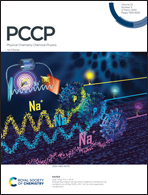Distinct effects of zwitterionic molecules on ionic solvation in (ethylene oxide)10: a molecular dynamics simulation study†
Abstract
Ion-containing polymers play a critical role in various energy and sensing applications. Adjusting ionic solvation is one approach to tune the performance of ion-containing polymers. Small zwitterionic molecule additives have presented their ability to regulate ionic solvation because they possess two charged groups covalently connected together. One remaining question is how the effect of zwitterionic molecules on ionic solvation depends on their own chemical structures, especially the anionic groups. To shed light on this question, we investigate the ionic solvation structure and dynamics in LiTFSI/(ethylene oxide)10 (EO10) with the presence of three distinct zwitterionic molecules (MPC, SB, and CB) using molecular dynamics simulations (MPC: 2-methacryloyloxyethyl phosphorylcholine, SB: sulfobetaine ethylimidazole, CB: carboxybetaine ethylimidazole, and LiTFSI: lithium bis(trifluoromethylsulfonyl)-imide). The simulation systems include two Li+ : O(EO10) molar ratios: 1 : 6 and 1 : 18. The simulation results show that all three zwitterionic molecules reduce the Li+–EO10 coordination number in the order of MPC > CB > SB. In addition, nearly 10% of Li+ exclusively coordinates with MPC molecules, only 2–4% of Li+ exclusively cooridinates with CB molecules, while no Li+ exclusively coordinates with SB molecules. MPC molecules also present the most stable Li+ coordination among the three zwitterionic molecules. Our simulations indicate that zwitterionic molecule additives may benefit a high Li+ concentration environment. At a low Li+ concentration, all three zwitterionic molecules reduce the diffusion coefficient of Li+. However, at a high Li+ concentration, only SB molecules reduce the diffusion coefficient of Li+.



 Please wait while we load your content...
Please wait while we load your content...